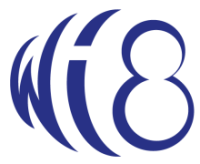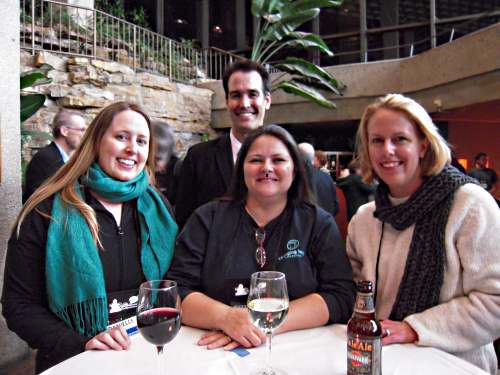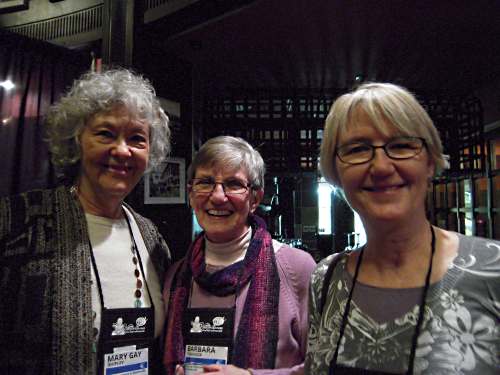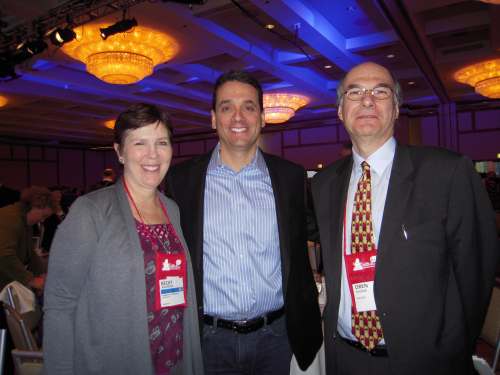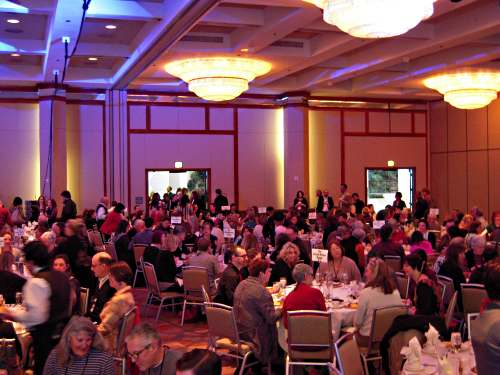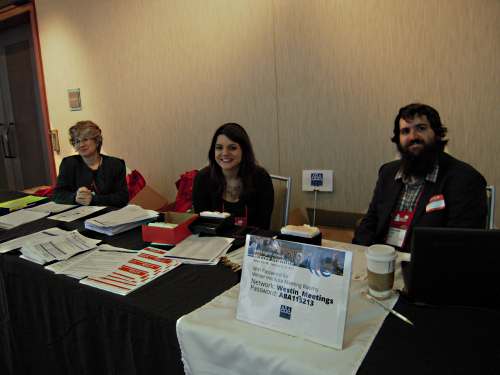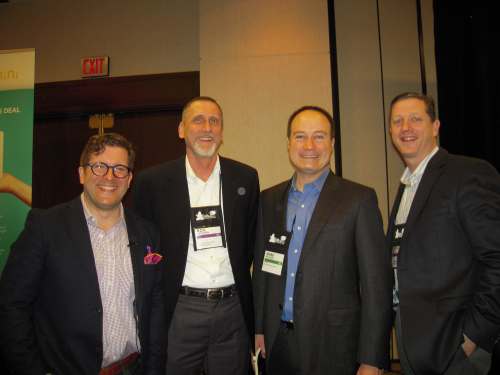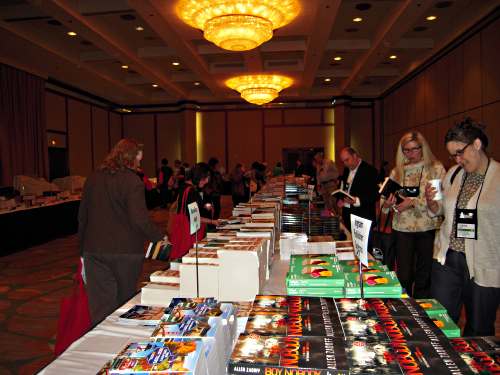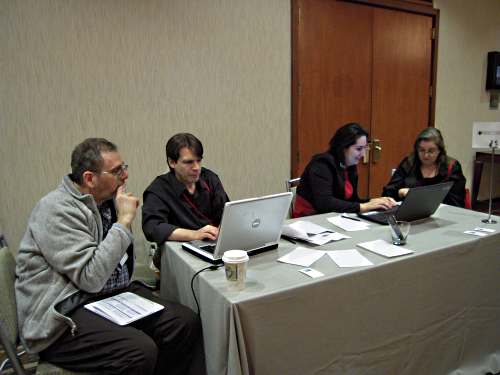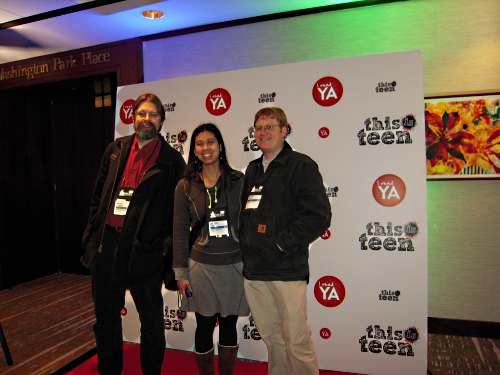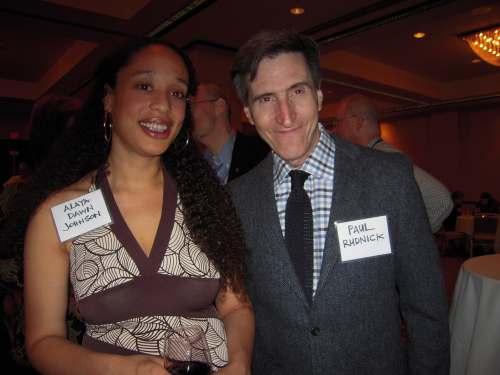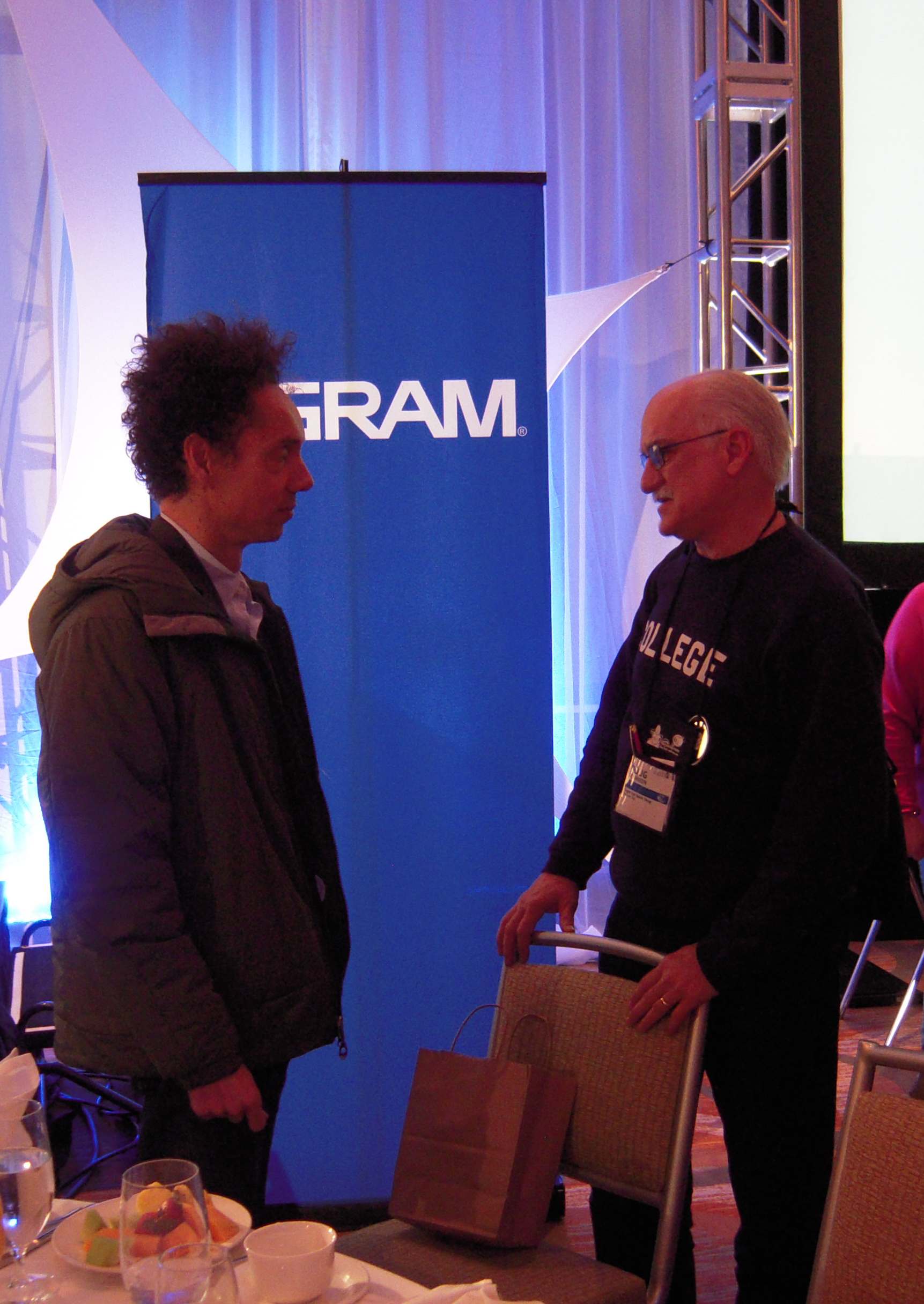- Categories:
Winter Institute 8: Day One Highlights and More
For those who may have missed our report from the Winter Institute, here, in photos and text, are highlights from the opening reception, the plenary sessions presented by bestselling authors Daniel Pink and Malcolm Gladwell, and other key happenings from the first full day of education through Sunday morning’s plenary session. Watch for reports on Wi8 education sessions and more in upcoming issues.
Festivities kicked off on Friday evening with an opening reception at landmark Union Station hosted by Kansas City’s own Andrews McMeel Publishing. Hundreds of booksellers attended the event, which provided the first opportunity for many to renew connections with old friends and to make new ones. Later in the evening, ABA hosted a Mingle by the Waterfall, the Westin hotel’s very own waterfall, that is.
ABA’s three days of educational programming began at 8:00 a.m. the following day in the Century Ballroom with a welcome from ABA CEO Oren Teicher. Noting that the snowstorm had created travel difficulties for many of the attendees, Teicher said, “How wonderful it is to stand up here and see you all.”
Teicher said that ABA had worked hard to create strong programming, but he also stressed that “you are the secret sauce to Wi8” and that the most important ingredient to the event’s success “is each and every one of you.”
Teicher also took the opportunity to thank Andrews McMeel for the previous evening’s warm welcome to Kansas City. “Throughout the evening last night at Union Station, you could feel that special Winter Institute vibe — and it was clear that once again you all have come to the Institute full of energy and enthusiasm ... which I know will fuel this entire event.”
ABA President Becky Anderson, whom Teicher said “has worked tirelessly on behalf of independent booksellers,” then took the podium to remind booksellers of a number of event highlights, including today’s trip to the CAMEX trade show. On behalf of all ABA members, Anderson extended a big thank you to Ingram Content Group, Wi8’s lead sponsor, and to all of the event’s Publisher Partners. “Ingram’s very generous, ongoing commitment to bookseller education allows ABA to offer year-round programming for our members, and to make low-cost hotel rates possible,” Anderson said. And the support of publisher sponsors and other friends of Wi8 “helps ensure the continued development of the Winter Institute and helps keep the education sessions free to ABA members.”
This year’s Galley Room, she noted, has more than 26,000 books that Wi8’s publisher sponsors have made available as galleys, advance reading copies, and finished books for booksellers to take home.
Anderson also noted the launch of pre-registration this week for Find Waldo Local 2013, which will take place in July. The nationwide campaign “to celebrate the uniqueness, fun, and strength of community” is sponsored by Candlewick and ABA.
Saturday Morning Opening Plenary With Daniel Pink: To Sell Is Human
In an engaging presentation, complete with visual aids, Daniel Pink discussed the topic of his new book, To Sell Is Human: The Surprising Truth About Moving Others (Riverhead), which is based on two ideas: like it or not, we’re all in sales now; and sales isn’t what it used to be. Pink revealed the results of a survey of 7,000 adult full-time workers, which showed that people, regardless of their industry, were spending about 40 percent of their time in a sales-type situation, which is why, he said, we’re all in sales now, like it or not. “And most people do not like it,” he added.
“A lot of people have a visceral, deep distaste for the whole concept of sales,” he said, and revealed a word cloud of the top 25 words that survey respondents thought of when they heard the word “sales” or “selling.” Of them, 20 were negative words, and five were positive, with the word “pushy” prominently shown in the middle of the cloud. When asked what image is associated with the word “sales,” respondents invariably pictured a sleazy car salesman, trying to cheat his customer.
But, Pink said, we no longer live in a world of “information asymmetry,” where the seller has a lot more information than the buyer, and the way to operate in this realm is to keep in mind the new ABCs of selling: Attunement, Buoyancy, and Clarity.
Attunement is taking another person’s perspective and trying to understand their interests and thoughts, which is integral when attempting to sell them something. Buoyancy is what is done to retain emotional equilibrium and optimism, and clarity is shifting from problem solving to problem finding. “Accessing information is not important anymore, said Pink. “It’s about taking the wealth of information and making sense of it, distilling meaningful patterns and curating it.”
Though many studies have looked at the relationship between extraverts and their personal success within a company, “the link between extraversion and sales performance is essentially zero,” he said. Pink then revealed the results of a recent study by Adam Grant of the University of Pennsylvania that measured the introversion and extroversion of salespeople at a software company in relation to their sales success. In a three-month period, the extraverts sold slightly more than introverts. But, neither group did as well as a third group, the “ambiverts,” a term that describes people who are somewhat introverted, somewhat extroverted. The result was a bell curve that showed extremely introverted people did poorly, and extremely extroverted people also did poorly.
Another study was done before a university food drive. Two groups of students — the most likely to give and the least likely to give — were split in half. One group — made up of both likely and not likely students — was given a general letter informing them of the food drive, and the other was given a more specific letter, addressing the student by name, and telling them more details of how to take part. Some of those that were least likely to participate and were given the more specific letter, did in fact, participate.
“When we think about people’s behavior, we overweight disposition and underweight context,” said Pink, adding that it happens every day in traffic. “When someone cuts you off, he’s a jerk. When you cut someone off, you’re in a hurry.
“The lesson for retail is that changing people’s minds often matters less than giving them an easy off ramp to act,” he said, adding that he wondered if sales would go up if booksellers had an iPhone with a Square Register attachment and app, allowing them to approach customers on the floor and offer to ring them out. “The easier you make it to act, the better,” he said.
Pink concluded with some ideas he received from his favorite business thinkers, after asking if they had something they’d like to share with a group of independent booksellers. Watch for more in an upcoming BTW.
Following Pink’s talk, booksellers met in 30 working groups, where they brainstormed actionable items to bring back to their own stores.
“What a good group of people to spend time with,” said Calvin Crosby of San Francisco’s Book Passage. “This was a perfect mix of engaged, interesting, and gracious people.” Pink’s plenary talk framed the discussion, “but the key takeaway was sharing and supporting one another,” Crosby said. The group talked about ideas that work in their stores already and things they were going to try, including name tags or T-shirts for staff, author pick shelves, and “book playlists.” There was also discussion about discovery and curation, both with books and sidelines, he added.
Discover Kobo 2013 Plenary
After the working groups, booksellers attended a presentation by Kobo Chief Content Officer Michael Tamblyn, who provided an update on the ABA/Kobo partnership and plans in the works for 2013. Kobo was designed, he said, to answer the question “What can bricks-and-mortar stores do” to face online competition?
The program has since grown to encompass 12 million Kobo users, 3.2 million titles in 66 languages, and 190 countries.
Tamblyn compared Kobo to ABA’s previous e-book partner, Google, and said that Kobo has the big advantage of giving stores “something tangible to sell, something physical for their stores” in the form Kobo eReaders. In addition, he said, Kobo provides indie booksellers with multiple revenue streams from the sale of devices, content, and accessories, all while keeping their own customers.
One of the challenges of working with U.S. independents as compared to Kobo’s previous work with big, national retailers, Tamblyn said, was finding a distribution channel. He said that Kobo and ABA had found that in Ingram Book Company, which he said “has been a fantastic fulfillment partner.”
To help stores train their staff to sell Kobo eBooks and eReaders, Tamblyn said that ABA and Kobo had worked to present informative sessions at the nine regional trade shows and that Kobo will be rolling out a 26-member field team over the next year.
Tamblyn also told indie booksellers that their customers think and act differently than other Kobo eBook buyers. An analysis of sales through indie bookstores to date found that their customers bought more expensive eBooks (57 percent of their purchases had a $9 price point or higher) and much fewer self-published or backlist titles. He also noted that the types of books themselves were different. Whereas the majority of Kobo eBook purchases were overwhelmingly fiction, he said, eBooks bought by indie bookstore customers were more balanced over three categories: 57.95 percent fiction, 11.53 percent juvenile fiction, and 30.19 percent narrative nonfiction. Though indie bookstore customers tended to make a slightly lower number of purchases, Tamblyn said that could be attributed in part to the fact that they bought books that took longer to read. That is, less romance and more literature and nonfiction.
Tamblyn told Wi8 attendees that Kobo’s goal in gathering these stats was “to get their arms around the indie bookstore customer to serve them better.”
In addition to providing training to enable indie bookstore staff to handsell Kobo eBooks and eReaders, Tamblyn told the audience that the look of Kobo.com will change in the next year to look more like an indie bookstore and that plans are in the works to foster sales of magazines, comics and graphic novels, and children’s and YA titles.
Booksellers who want to keep and grow their customer relationships need to keep in mind that “book-loving traditionalists are just starting to go digital,” Tamblyn said, and the ability to sell eBooks can keep that customer relationship together. Additionally, he said, booksellers can use eBooks to fill a supply chain gap, when someone is in the store looking for a print book that is out of stock, booksellers can point the customers to an eBook instead.
Saturday also featured the first of two Rep Picks lunches, which was followed by two sessions of five breakout education sessions each.
One Institute, One Read: A Good American
The day’s sessions ended with pretzels and beer and a talk with Alex George, author of the One Institute, One Read choice, A Good American (Amy Einhorn/Putnam). George was introduced by Rainy Day Books co-owner Vivien Jennings. The store had sponsored a scholarship to Wi8 to the ABA member store that sold the most copies of A Good American between then and mid-November. Kansas City Star senior arts editor Steve Paul conducted the interview, and began by asking George, who was born and raised in England, about his motivation to write this book. “Every family has a story like this,” said George, adding that the desire to fit in is prevalent. The book’s third-generation character, James, is a writer, who is desperately trying to get published, which parallels George’s own experience of publishing A Good American.
George discussed the book’s recurring theme of music, something he is very passionate about, as well as the more unpleasant aspects of the novel — profound and sinister racism — which he noted, while disturbing, is a very real part of American history.
“Writers are told to write what you know,” George said. “But it’s also important to write what you’re passionate about, because I think that comes through on the page.”
In a compelling example of life imitating art, George revealed that just days after the book was published, he went to the courthouse, and like his own characters, took an oath of allegiance and officially became a U.S. citizen.
Sunday Morning Plenary With Malcolm Gladwell: David and Goliath
At the Sunday morning session, ABA Vice President Steve Bercu introduced plenary speaker Malcolm Gladwell, who took the stage and immediately thanked the audience of booksellers. “I’ve always been aware of how much of my success is due to your efforts,” he said.
Gladwell’s forthcoming book, David and Goliath (Little, Brown), is an outgrowth of a 2009 piece he wrote for the New Yorker that focuses on an ill-trained 12-year-old girls’ club basketball team from Menlo Park. To make up for their lack of skills and strength on the court, their coach — a newcomer to the game himself — advised the team to employ a non-stop, full-court press to defeat their opponents. This strategy — though unconventional, and obnoxious, even — allowed the team to advance to the championship.
After writing the piece, “I couldn’t get it out of my head,” Gladwell said. “It struck me that there was something profoundly interesting about that story because it seemed to upend so many notions we have about what an advantage is.” The team was forced to innovate, and they were doing so out of weakness instead of strength. “As it turns out, compensation strategies are as important as capitalization strategies,” said Gladwell, adding that it was the team’s “underdog-ness” that allowed them to break the rules, and try something that no one else was trying.
“If underdogs are in the position to innovate and to break the rules and those two things allow them to win games, why do we call them underdogs?” he asked, and then explained that this is the question explored in his new book.
One chapter of the book deals with the problem of the “inverted-U curve.” Many of us are familiar with linear curves used to demonstrate that as resources are added, things get better, Gladwell said. An example of this would be that $20,000 car is twice as good as a $10,000 car. We’re also familiar with the concept of diminishing marginal returns — that after a certain point, spending money doesn’t get you that much more — or, a $200,000 car is not twice as good as a $100,000 car.
“The curve we don’t understand,” he said, “is the one that says, things start getting better, then they flatten out. And after a while, they get worse as you add more resources.”
Gladwell pointed to the movement to reduce school class sizes, a facet of educational reform that is foremost in many decision-makers’ minds, and is the most expensive to execute. While we, as a country, spend millions of dollars to try to reduce class sizes, it remains incredibly difficult to find evidence that doing so has a definitively positive effect on students. This is because class size reduction lies on an inverted-U curve, Gladwell said. If you start with a class of 40 students, and reduce to 30, “kids are better off, absolutely,” he said. Further reducing a class to 25 would not make much of a difference. Continuing to diminish the class to 15 would be detrimental, he said, for a variety of reasons.
Thousands of teachers responded with a resounding “yes” in a survey that asked, “Can a class size be too small?” Reasons given for their affirmative responses were that class discussions become more difficult, students become more self-conscious, and small classes can be — paradoxically — harder to control.
“When it comes to navigating the difference between advantages and disadvantages, we do a really bad job,” said Gladwell. “There’s something about making sense of those two categories that baffles us.”
David and Goliath is a perfect illustration of that problem, he continued. “We got that story wrong.”
In ancient times, there were three kinds of warriors, he continued: heavy infantry, cavalry, and projectile warriors, which included slingers. They had a relationship that was “like rock-paper-scissors,” said Gladwell. Cavalry could defeat slingers because slingers couldn’t hit a moving target, slingers could defeat infantry because they were slow, and infantry could defeat cavalry.
David is a slinger and Goliath is an infantryman. “Everyone in ancient times knew that when slingers met infantryman, slingers win,” said Gladwell. “This is not a story about some innocent waif who unexpectedly pulled an upset against an overpowering giant — nonsense! The moment Goliath realizes he’s up against a slinger, he’s like ‘oh, no.’
“If we’ve been getting that most fundamental story about underdogs and favorites wrong, for four thousand years, how many other questions of advantage and disadvantage have we also been getting wrong?” Gladwell asked.
He then opened the floor to questions from the audience. Asked how the inverted-U curve could be applied to bookstores, Gladwell said, “Your world is a really wonderful illustration of this notion.” The world is not on the kind of continuum, where as a store gets larger, it automatically gets better, he explained. “There are a host of other considerations at play.”
“When I go to a bookstore I like the sense that some kind of thought has gone into what is in the store. Someone has decided what is worthy of being on the shelf and what is not.” The intimacy of the space is another factor. “There are a whole series of variables that are apart from resources.”
While there’s no question that the book industry is going to change in size and shape in the coming years, Gladwell concluded, “it will never be the case that every book in this country will be ordered online, never. And I say that with absolute confidence.” —Elizabeth Knapp and Rosemary Hawkins
Watch for more on Winter Institute 8 in upcoming editions of BTW.


